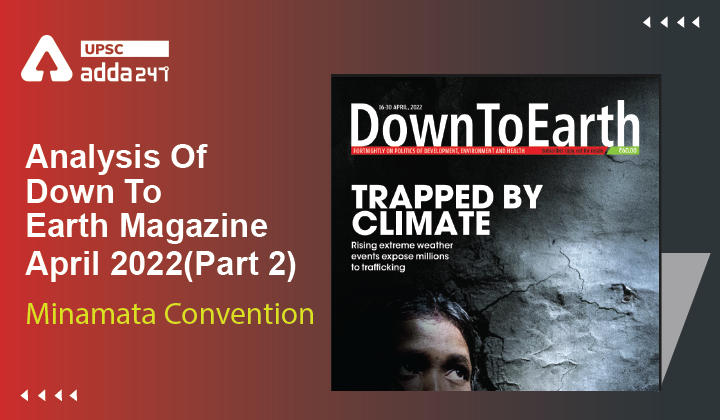Table of Contents
Analysis Of DTE Magazine ”Minamata Convention”
Relevance
”GS 3: Environmental Pollution & Degradation”
Context
- On March 25, 2022, world leaders from 137 countries agreed to stop the illegal use of mercury at the fourth Conference of the Parties to Minamata Convention, in Bali, Indonesia.
- Though non-binding, the countries pledged for the first time to reduce the use of mercury in artisanal and small-scale gold mining, which is the largest source of mercury pollution in the world.
About Minamata Convention
- The Minamata Convention draws attention to a global and ubiquitous metal(Mercury) that, while naturally occurring, has broad uses in everyday objects and is released into the atmosphere, soil and water from a variety of sources.
- Controlling the anthropogenic releases of mercury throughout its lifecycle has been a key factor in shaping the obligations under the Convention.
When was the convention entered into force?
- The Convention was agreed at the fifth session of the Intergovernmental Negotiating Committee on mercury in Geneva, Switzerland on 19 January 2013 and adopted later that year on 10 October 2013 at a Diplomatic Conference (Conference of Plenipotentiaries), held in Kumamoto, Japan.
- The Minamata Convention entered into force on 16 August 2017, on the 90th day after the date of deposit of the 50th instrument of ratification, acceptance, approval or accession.
Timeline of Minamata Convention

Dangers Of Mercury
- The element is so toxic that there is no safe level of exposure to it.
- It damages the nervous, digestive and immune systems, and is particularly harmful to children.
- Artisanal gold miners usually combine the toxic heavy metal with gold ore and then burn it to extract pure gold.
- The method accounts for 38 per cent of the world’s total emissions and releases of mercury, as per the United Nations Environment Programme (UNEP).
Major highlights of the Minamata Convention
- Ban on new mercury mines.
- The phase-out of existing Mines.
- The phase-out and phase-down of mercury use in a number of products and processes.
- Control measures on emissions to air and on releases to land and water.
- The regulation of the informal sector of artisanal and small-scale gold mining.
- The Convention also addresses interim storage of mercury and its disposal once it becomes waste, sites contaminated by mercury as well as health issues.
Conclusion
Efforts like the Bali Declaration are helpful in raising awareness. But the willingness and ability of the countries is what matters.



 TSPSC Group 1 Question Paper 2024, Downl...
TSPSC Group 1 Question Paper 2024, Downl...
 TSPSC Group 1 Answer key 2024 Out, Downl...
TSPSC Group 1 Answer key 2024 Out, Downl...
 UPSC Prelims 2024 Question Paper, Downlo...
UPSC Prelims 2024 Question Paper, Downlo...




